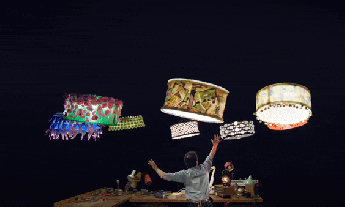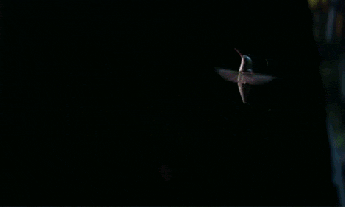
Raffaello D’Andrea (TED Talk: The astounding athletic power of quadcopters) stunned the audience with his super agile flying machines at TEDGlobal 2013. In a robot lab built on site, D’Andrea demoed tricks and feats to a hushed but delighted crowd, including a quadcopter that flew around the room with a glass of water perched on top, not spilling a drop. We caught up with D’Andrea to see what he and his tiny, powerful flying machines were up to. Below are three new applications his team has produced in the last year.
What happens when a quadrocopter loses a propeller? NOTHING, THAT’S WHAT
Normally when a quadcopter loses a propeller, it crashes to the ground. In this clip a quad loses a propeller, “realizes” it has lost a propeller, then stabilizes itself. Using physics-based models and mathematical tools, D’Andrea and his team determined that even with the loss of a motor, it would be possible for it to regain control. As such, when the quad senses it has lost a propeller, it cedes control over its yaw, or its vertical rotation, and just rotates at will. As D’Andrea’s team calculated, when this happens the quad can remain stable with three or even two propellers. This method can be used to continue flying or to make a safe landing without damaging the quad.
This video demonstrates that the algorithm can work outside the lab as well as inside the lab. Normally cameras and laptops are used to capture where the quad is in space and adjust its position accordingly. Here the quad has inertial sensors like accelerometers, barometers and magnetometers built into it to tell it where it is in space, eliminating the need for external equipment.
This algorithm minimizes the need for redundant propellers and makes flying machines lighter and more cost effective. It also allows for the design of even lighter flying machines, with two or three propellers, which is what D’Andrea’s team is working on now. (There are some versions available with fewer propellers, but this type, with fixed propellers and without variable pitch, is cheaper, less complex, and thus far only made with four propellers.) One can’t help but speculate that these will be useful in military applications, with stray bullets flying and unexpected scenarios on the ground.
Quadcopters are smarter than you are. Or, what happens when a quadcopter learns to fly
Here a quad learns to fly a very precise trajectory very quickly. As you can see, in Lap 1 the quad is pretty far off the red path; by Lap 30, it’s making a figure 8 perfectly.
The algorithm allows a machine to track its mistakes and learn from them. Even though the algorithm isn’t good enough to tell the machine how to follow the trajectory perfectly to begin with, it can tell it how to change its actions and improve the next time. The same is true in human learning: It’s easier to take a few basketball shots and improve over a few tries than it is to get it in the basket on the first try.
This can be used for applications like photography, which requires precise flying to capture shots with a subject centered and in focus. D’Andrea and his team (TEDx Talk: Markus Hehn: Learning algorithms in aerial vehicles) were able to use a quad to capture perfect photos (in this example, D’Andrea juggling) within ten or twelve tries.
Cat’s cradle as you’ve never seen it played before
This video is part of a project to redefine the process of architectural construction. Tensile structures such as ropes and strings only have strength when they’re taut. This means ropes are more difficult to work with architecturally — but also that they’re easy for flying machines to manipulate. A machine can basically just fly around and deploy rope wherever necessary. This is useful for aerial construction, a new field D’Andrea believes has a lot of potential.
[ted id=1764]
Featured image courtesy of ETH Zurich Flying Machine Arena.













